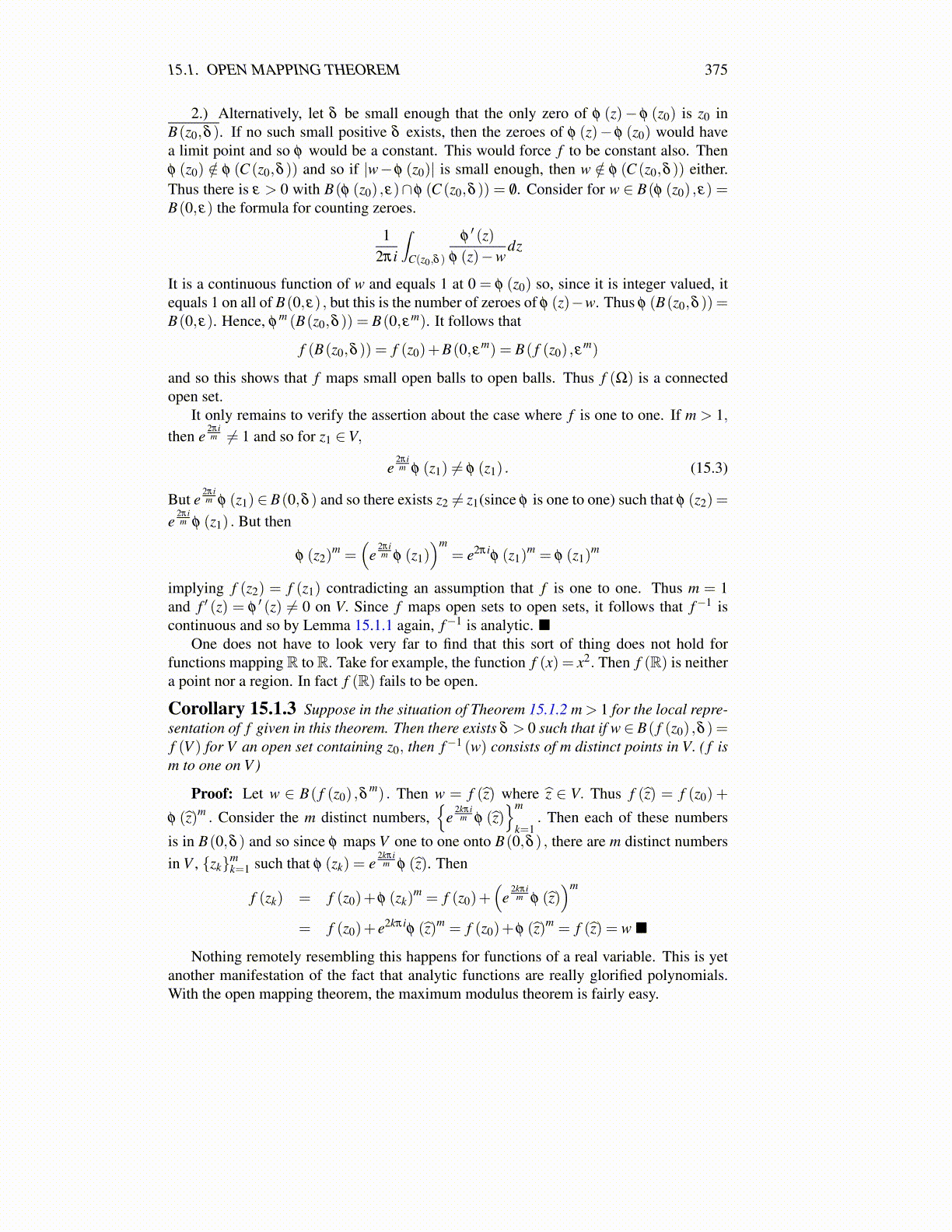
15.1. OPEN MAPPING THEOREM 375
2.) Alternatively, let δ be small enough that the only zero of φ (z)− φ (z0) is z0 inB(z0,δ ). If no such small positive δ exists, then the zeroes of φ (z)− φ (z0) would havea limit point and so φ would be a constant. This would force f to be constant also. Thenφ (z0) /∈ φ (C (z0,δ )) and so if |w−φ (z0)| is small enough, then w /∈ φ (C (z0,δ )) either.Thus there is ε > 0 with B(φ (z0) ,ε)∩φ (C (z0,δ )) = /0. Consider for w ∈ B(φ (z0) ,ε) =B(0,ε) the formula for counting zeroes.
12πi
∫C(z0,δ )
φ′ (z)
φ (z)−wdz
It is a continuous function of w and equals 1 at 0 = φ (z0) so, since it is integer valued, itequals 1 on all of B(0,ε) , but this is the number of zeroes of φ (z)−w. Thus φ (B(z0,δ )) =B(0,ε). Hence, φ
m (B(z0,δ )) = B(0,εm). It follows that
f (B(z0,δ )) = f (z0)+B(0,εm) = B( f (z0) ,εm)
and so this shows that f maps small open balls to open balls. Thus f (Ω) is a connectedopen set.
It only remains to verify the assertion about the case where f is one to one. If m > 1,then e
2πim ̸= 1 and so for z1 ∈V,
e2πim φ (z1) ̸= φ (z1) . (15.3)
But e2πim φ (z1)∈ B(0,δ ) and so there exists z2 ̸= z1(since φ is one to one) such that φ (z2) =
e2πim φ (z1) . But then
φ (z2)m =
(e
2πim φ (z1)
)m= e2πi
φ (z1)m = φ (z1)
m
implying f (z2) = f (z1) contradicting an assumption that f is one to one. Thus m = 1and f ′ (z) = φ
′ (z) ̸= 0 on V. Since f maps open sets to open sets, it follows that f−1 iscontinuous and so by Lemma 15.1.1 again, f−1 is analytic. ■
One does not have to look very far to find that this sort of thing does not hold forfunctions mapping R to R. Take for example, the function f (x) = x2. Then f (R) is neithera point nor a region. In fact f (R) fails to be open.
Corollary 15.1.3 Suppose in the situation of Theorem 15.1.2 m > 1 for the local repre-sentation of f given in this theorem. Then there exists δ > 0 such that if w∈ B( f (z0) ,δ ) =f (V ) for V an open set containing z0, then f−1 (w) consists of m distinct points in V. ( f ism to one on V )
Proof: Let w ∈ B( f (z0) ,δm) . Then w = f (ẑ) where ẑ ∈ V. Thus f (ẑ) = f (z0) +
φ (ẑ)m . Consider the m distinct numbers,{
e2kπi
m φ (ẑ)}m
k=1. Then each of these numbers
is in B(0,δ ) and so since φ maps V one to one onto B(0,δ ) , there are m distinct numbersin V , {zk}m
k=1 such that φ (zk) = e2kπi
m φ (ẑ). Then
f (zk) = f (z0)+φ (zk)m = f (z0)+
(e
2kπim φ (ẑ)
)m
= f (z0)+ e2kπiφ (ẑ)m = f (z0)+φ (ẑ)m = f (ẑ) = w ■
Nothing remotely resembling this happens for functions of a real variable. This is yetanother manifestation of the fact that analytic functions are really glorified polynomials.With the open mapping theorem, the maximum modulus theorem is fairly easy.